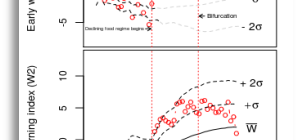
Background Theory predicts that the logarithm of mean extinction times will scale with patch carrying capacity. Although previous results are consistent with this theory over…

Background Few experimental or observational datasets are available from which to learn about the stochastic properties of extinction. Particularly, there have been no large studies…

Background. Theory predicts that extinction rates should be lower in constant environments than in randomly fluctuating environments with the same average conditions. This is because…

It is well understood that natural populations do not necessarily reflect the assumption of a homogeneous well-mixed population assumed by most of theories of population…

Background. Population persistence is predicted by theory to increase with carrying capacity and a population’s capacity to increase rapidly. We view both carrying capacity and…

Above Test tube habitats for individual D. magna raised under different food resource fluctuation schemes How individual organisms modify their life trajectories to cope with…

Above – A composite early warning index comprising all four indicators is highly sensitive to the onset of critical slowing down. a, Time-specific calculations of…

One of the interesting things about the theory of population extinction is that despite widely differing processes for the cause of extinction (demographic stochasticity, environmental…

Background. Recent studies on animal populations in the field have attributed positive-density dependence at low density to a predator-driven Allee effect (e.g. Wittmer et al….





